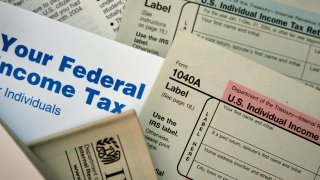
It’s about to get a little easier for you to figure out how to break even or get a bigger tax refund from Uncle Sam.
The IRS kicked off the new year with a revamp of its tax withholding estimator tool, a calculator that helps you fine-tune the amount of federal income taxes that are pulled from your paycheck.
Tax withholding is a balancing act. If you withhold too little, you will wind up owing the IRS when you file your taxes.
Overpay your taxes, and you’ll get a heftier refund. The downside is your take-home pay will go down.
This latest round of updates to the IRS withholding tool allows users to plug in their pay information and find out how much they may owe or get back in the 2020 tax year.
This is for the return you’ll be filing in April, 2021.
U.S. & World
An interactive slider on the calculator allows you to tweak your expected refund or lower your expected bill in increments of $250, and gives you directions on how to adjust your withholding — as well as that of your spouse — to get the desired amount back.
You can even aim for a refund of approximately $0, meaning you’ve just about broken even with the IRS.
“A lot of people want to tailor their refund; they might not want it to be so big that they don’t have that money throughout the year,” said Eric Smith, a spokesman for the IRS.
Be aware that it’s mostly too late to overhaul your 2019 tax picture, but you can right the ship for 2020.
A total revamp
In December, the IRS released a new Form W-4 for the 2020 tax year. Workers use this document to detail how much income tax is withheld from their pay.
This new form, along with a 2018 overhaul of the withholding tables, reflects changes from the Tax Cuts and Jobs Act.
The new tax law, which took effect two years ago, nearly doubled the standard deduction, eliminated personal exemptions and curbed certain itemized deductions, including applying a new $10,000 cap on the state and local tax deduction.
Under the old law, the IRS used to ask taxpayers to detail the number of allowances claimed on their W-4. The more allowances you claimed — for yourself, your spouse and your dependents — the less tax you’d have withheld from your pay.
Now, those who might have taken many allowances could find themselves paying far too little in taxes.
“The tables were adjusted, but people didn’t adjust their withholding,” said Cari Weston, CPA and director of tax practice and ethics for the American Institute of CPAs.
“They got more in their paychecks and were in a panic because people owed the IRS when they normally didn’t or their refunds were smaller,” she said.
The new W-4 now wants you to detail the number of qualifying children in your household, as well as the number of “other dependents” you care for.
You would also be factoring in the $2,000 child tax credit for each kid under 17 or the $500 credit for other qualifying dependents.
Further, the IRS wants you to share information on whether you held more than one job, or whether you and your spouse work and file jointly.
This way, you can pinpoint your withholding based on income earned from all those jobs.
“The old W-4 never considered that people would have multiple sources of income,” said Weston.
You can also spell out the number of deductions you expect to claim if you think you’ll be itemizing on your return. This way, you’d lower your withholding and take more money home.
Update your withholding
Whether you’re consulting your CPA or hashing out the numbers yourself with the IRS withholding calculator, plan to dust off your 2018 income tax return, as well as your last paystub for 2019.
Both sets of documents will give you an idea of where you stand for 2020.
If you fit one of these categories, make a point of revisiting your withholding:
• Employees with side income: “The rule of thumb used to be to set aside 25% of your side gig income for quarterly estimated taxes,” said Weston. If you’re not doing this, see if increasing your withholding at work can help you account for that tax payment.
• People who no longer itemize: If you used to itemize deductions and had fewer taxes withheld from your pay, take a second look at your W-4. More taxpayers claim the standard deduction since it’s been doubled to $12,400 for singles and $24,800 for married filing jointly.
• Families with kids, older adults and other dependents: It used to make sense to withhold less tax if you had dependents. Now that those personal and dependent exemptions are out the door, it’s time to take a closer look.
The child tax credit has been broadened to include higher-income households, and there’s a new $500 tax credit for “other dependents” who reside with you.
This story first appeared on CNBC.com. More from CNBC:



